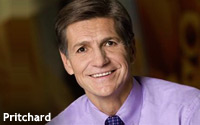P&G's Pritchard To Brands: Join The Conversation
- by Steve McClellan @mp_mcclellan, March 11, 2013
 NEW ORLEANS -- Is the dizzying array of
new media overshadowing the impact of the creative message in the advertising business?
NEW ORLEANS -- Is the dizzying array of
new media overshadowing the impact of the creative message in the advertising business?
Mark Pritchard, P&G global branding officer, fears that is the case, as he told a crowd gathered
at the 4A’s Transformation Conference in New Orleans Monday morning.
“We talk a lot about the medium and not enough about the message,” he told the 4As attendees, gathered
at the recently re-opened Hyatt Regency hotel, which underwent a five-year $600 million post-Katrina renovation.
Ideas that get people talking about brands need to “transcend the
medium,” Pritchard said. Such ideas, he said, have been taken “a little bit for granted” of late.
Brands need to become part of consumers’ “shared
experience,” Pritchard said. Creative ideas help that happen, and there’s no reason why media fragmentation should be a barrier.
“Brands can become an authentic
part” of the shared consumer conversation, Pritchard said.
He cited a campaign done recently by subsidiary Duracell to help victims of Hurricane Sandy. Called “Power
Forward,” the company, using branded vehicles, went to areas affected by the storm and dispersed 23,000 packs of flashlight batteries to 10,000 families left without power and lights.
The campaign attracted huge media attention, and the company shot videos documenting the effort and the plight of some of the victims and how the batteries helped. It got people talking about
Duracell, said Pritchard. A “tiny investment,” he said, generated “huge ROI,” with earned media from the campaign more than doubling paid media.
advertisement
advertisement



There is no data in sight behind this pronouncement. Really?! I think we need to move from the era of narrative to the era of evidence in figuring out what marketing must look like in our digital, social, and mobile future.
Not sure I get the point of this story. How did media get in the way of P&G's "poached" media effort. Seems to me that disaster zones may well be a place to share the experience, so to speak, but only P.T. Barnum and Donald Trump would expect "double the payback" on the investment. Either Mark is moving a bit too fast or the writer is a bit unfocused or I am a bit thick, but this story doesn't set well.
An important point underlying what Pritchard and others making similar claims are saying is that is no precise way to measure in advance the sum total response a brand will get from a given effort (active, passive, emotional, etc.), so the message needs to come first to maximize likelihood of response. There's no such thing as "emotional attribution," no way to know that an Oreo creative produced during a blackout will cause industry-wide conversation for a week or more, etc. Plenty of companies focus on seeding things virally (or at least attempting to); but ultimately, it's what people do, how they react to a message (perhaps passively even more than actively), that is the measure of its success... and there's just no way to quantify human emotion before it's triggered. The best we can do is put it first when designing experiences... "transcend the medium" and consider the message, the desired emotions, where the intersection of brand and consumer is, and so on. This, of course, is a slightly different conversation from measuring the effectiveness of online direct response advertising, but the message is similar: you won't get anyone to do anything if the message doesn't resonate, wherever and whenever it is.
I have to agree with Timothy Mcmahon here and wonder: how is media getting in the way? Unless the writer is to say that some brands ONLY use the media to deliver their message when instead, as Pritchard writes, they should be sharing the physcial eexperience.
I take it to maybe mean this: brands are starting to get lazy behind their message boards and blogs and DM pieces, and isntead they must "Transcend the mdeium" in the sense that they need to get out into the PHYSICAL world and be part of their own message. Not just write it down on paper and send it into cyberspace.
I still wonder though, if saying "media is getting in the way" is the right way to phrase it. We can all agree media can be a huge help in delivering information about a shared consumer experience, no?